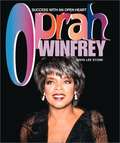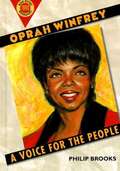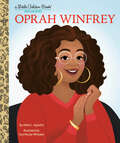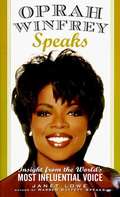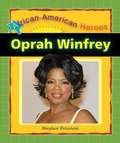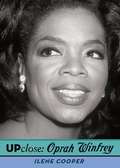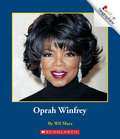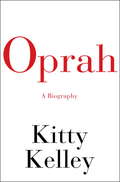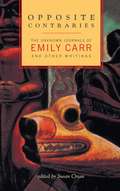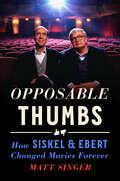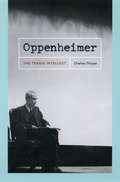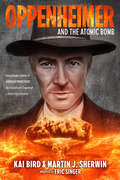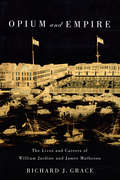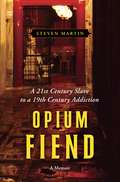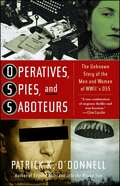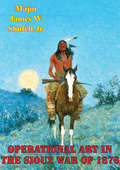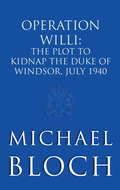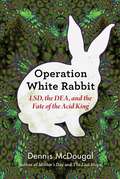- Table View
- List View
Oprah Winfrey: Success With an Open Heart
by Tanya Lee StoneFrom humble beginnings and a troubled childhood, Oprah Winfrey is now a media icon. Her continued success as a talk show host and film producer, combined with a spate of new projects, including the launch of O: The Oprah Magazine and involvement with the Oxygen Channel, indicate that Oprah has no intention of slowing down anytime soon. This book presents the life of a fascinating person, with an emphasis on Oprah's accomplishments as an African-American woman.
Oprah Winfrey: Queen of Daytime TV
by Ann WeilOprah's career in broadcasting began by accident when she was only 17 years old. Even then, it was clear that she was a natural, and Oprah was offered a job as a part-time newscaster when all she had sought was a charitable contribution from radio station WVOL in Nashville! She firmly believes that her success is part of a divine plan for her life, aided by her own undeniable talent and ability. Her willingness to share the problems in her life has endeared her to millions, and the little girl who once shared a bed with her grandmother (who taught her to read and write at age three) in a house with no indoor plumbing has gone on to become one of the wealthiest, most powerful, and most highly-regarded people in the entertainment industry today.
Oprah Winfrey: Media Success Story
by Anne SaidmanExamines the life of the actress and talk show host, from her childhood on a farm in Mississippi to her achievements in broadcasting and film.
Oprah Winfrey: A Voice For The People
by Philip BrooksHere is a series for students challenged with one of their most typical assignments: write a book report on a book of 100 pages or more. Each Book Report Biography tells the story of a significant person from the past (from politics, science, or the arts) or present (some of today's hottest celebrities and sports heroes).
Oprah Winfrey: A Little Golden Book Biography (Little Golden Book)
by Alliah L. AgostiniHelp your little one dream big with a Little Golden Book biography about talk show host, producer, and actor Oprah Winfrey. Little Golden Book biographies are the perfect introduction to nonfiction for young readers—as well as fans of all ages!This Little Golden Book about Oprah Winfrey--host of the highest-rated daytime talk show in American history, and one of the most influential and successful women in the world--is an inspiring read-aloud for young children, as well as their parents and grandparents.Look for more Little Golden Book biographies: • Misty Copeland • Frida Kahlo • Iris Apfel • Bob Ross • Queen Elizabeth II • Harriet Tubman
Oprah Winfrey Speaks: Insight from the World's Most Influential Voice
by Janet LoweOprah is not just another famous entertainer. She's a friend to the world and a role model for all people, of any gender, of any race, of any group. Before reading Oprah Winfrey Speaks, here are some guidelines on what to expect from the book. It will not be focused on the well-known details of Oprah's life and rise to stardom, although this information is presented to give the reader a better perspective on the comments. Rather, the book emphasizes the lessons that Winfrey has learned along the way--lessons many of us can profit from. Oprah has taught us a lot, and I've tried to capture as much of that wisdom as possible.
Oprah Winfrey (African-American Heroes)
by Stephen FeinsteinOprah Winfrey overcame a difficult childhood to become one of America's most famous women--an actress, talk-show host, philanthropist, and more. This easy biography, with its lively format and colorful illustrations, tells her story. The accessible vocabulary makes it ideal for early independent readers.
Oprah Winfrey
by Ilene CooperOprah Winfrey has been called the Queen of All Media for good reason. During her more than thirty-year career, she has left an indelible mark on radio, television and books. One of the influential people today, Oprah is also a committed humanitarian.
Oprah Winfrey
by Jean F. BlashfieldTrailblazer Oprah Winfrey is a determined woman who escaped a difficult childhood to become one of the most powerful people in the United States. A gifted speaker and successful businesswoman, Oprah produces television programs, motion pictures, and a magazine, but she also uses her media outlets to encourage people to take personal and social action in order to improve their own lives as well as those of others. Her humanitarian efforts help people worldwide.
Oprah Winfrey
by Wil MaraThe Rookie Biographies series features historical and contemporary people who will captivate emergent readers. Each biography introduces readers to the lives and achievements of pioneering men and women from diverse cultures, eras, and fields. Featuring simple text and full-color photographs, a "Words You Know" glossary, and an easy-to-use index, this series helps readers get to know the people who shaped our world. In this title, young readers will learn about Oprah Winfrey's rags to riches story. Discover how Winfrey grew up in poverty but, while attending college, discovered her talent as a news reporter and talk show host. Now, Winfrey's show is one of the most watched on daytime television, she owns a production company, and publishes a magazine.
Oprah
by Kitty KelleyBased on three years of research and reporting as well as 850 interviews with sources, many of whom have never before spoken for publication, Oprah is the first comprehensive biography of one of the most influential, powerful, and admired public figures of our time, by the most widely read biographer of our era. Anyone who is a fan of Oprah Winfrey or who has followed her extraordinary life and career will be fascinated and newly informed by the closely observed, detailed, and well-rounded portrait of her provided by Kitty Kelley's exhaustively researched book. Readers will come away with a greater appreciation of who Oprah really is beyond her public persona and a fuller understanding of her important place in American cultural history.
Oprah
by Kitty KelleyFor the past twenty-five years, no one has been better at revealing secrets than Oprah Winfrey. On what is arguably the most influential show in television history, she has gotten her guests--often the biggest celebrities in the world--to bare their love lives, explore their painful pasts, admit their transgressions, reveal their pleasures, and explore their demons. In turn, Oprah has repeatedly allowed her audience to share in her own life story, opening up about the sexual abuse in her past and discussing her romantic relationships, her weight problems, her spiritual beliefs, her charitable donations, and her strongly held views on the state of the world.After a quarter of a century of the Oprah-ization of America, can there be any more secrets left to reveal?Yes. Because Oprah has met her match.Kitty Kelley has, over the same period of time, fearlessly and relentlessly investigated and written about the world's most revered icons: Jacqueline Kennedy Onassis, Frank Sinatra, Nancy Reagan, England's Royal Family, and the Bush dynasty. In her #1 bestselling biographies, she has exposed truths and exploded myths to uncover the real human beings that exist behind their manufac¬tured facades.Turning her reportorial sights on Oprah, Kelley has now given us an unvarnished look at the stories Oprah's told and the life she's led. Kelley has talked to Oprah's closest family members and business associates. She has obtained court records, birth certificates, financial and tax records, and even copies of Oprah's legendary (and punishing) confidentiality agreements. She has probed every aspect of Oprah Winfrey's life, and it is as if she's written the most extraordinary segment of The Oprah Winfrey Show ever filmed--one in which Oprah herself is finally and fully revealed.There is a case to be made, and it is certainly made in this book, that Oprah Winfrey is an important, and even great, figure of the twentieth and twenty-first centuries. But there is also a case to be made that even greatness needs to be examined and put under a microscope. Fact must be separated from myth, truth from hype. Kitty Kelley has made that separation, showing both sides of Oprah as they have never been shown before. In doing so she has written a psychologically perceptive and meticulously researched book that will surprise and thrill everyone who reads it.
Opposite Contraries
by Emily Carr Susan CreanCollected from Emily Carr's private and public writings, these previously unpublished pieces reveal the outspoken artist at her most forthright. Expurgated sections from Carr's journals detail her anguished meditations on her spiritual mission, musings about Native culture and the white community's reaction to it, and thoughts about her family. Her groundbreaking 1913 "Lecture on Totems", her first recorded writing on Native art and people, is also included, as are some of her most fascinating letters to friends and colleagues.
Opposable Thumbs: How Siskel & Ebert Changed Movies Forever
by Matt SingerOnce upon a time, if you wanted to know if a movie was worth seeing, you didn&’t check out Rotten Tomatoes or IMDB.You asked whether Siskel & Ebert had given it &“two thumbs up.&”On a cold Saturday afternoon in 1975, two men (who had known each other for eight years before they&’d ever exchanged a word) met for lunch in a Chicago pub. Gene Siskel was the film critic for the Chicago Tribune. Roger Ebert had recently won the Pulitzer Prize—the first ever awarded to a film critic—for his work at the Chicago Sun-Times. To say they despised each other was an understatement.When they reluctantly agreed to collaborate on a new movie review show with PBS, there was at least as much sparring off-camera as on. No decision—from which films to cover to who would read the lead review to how to pronounce foreign titles—was made without conflict, but their often-antagonistic partnership (which later transformed into genuine friendship) made for great television. In the years that followed, their signature &“Two thumbs up!&” would become the most trusted critical brand in Hollywood.In Opposable Thumbs, award-winning editor and film critic Matt Singer eavesdrops on their iconic balcony set, detailing their rise from making a few hundred dollars a week on local Chicago PBS to securing multimillion-dollar contracts for a syndicated series (a move that convinced a young local host named Oprah Winfrey to do the same). Their partnership was cut short when Gene Siskel passed away in February of 1999 after a battle with brain cancer that he&’d kept secret from everyone outside his immediate family—including Roger Ebert, who never got to say goodbye to his longtime partner. But their influence on in the way we talk about (and think about) movies continues to this day.
Oppenheimer: The Tragic Intellect (Interspecific Interactions Ser.)
by Charles ThorpeAt a time when the Manhattan Project was synonymous with large-scale science, physicist J. Robert Oppenheimer (1904–67) represented the new sociocultural power of the American intellectual. Catapulted to fame as director of the Los Alamos atomic weapons laboratory, Oppenheimer occupied a key position in the compact between science and the state that developed out of World War II. By tracing the making—and unmaking—of Oppenheimer’s wartime and postwar scientific identity, Charles Thorpe illustrates the struggles over the role of the scientist in relation to nuclear weapons, the state, and culture. A stylish intellectual biography, Oppenheimer maps out changes in the roles of scientists and intellectuals in twentieth-century America, ultimately revealing transformations in Oppenheimer’s persona that coincided with changing attitudes toward science in society. “This is an outstandingly well-researched book, a pleasure to read and distinguished by the high quality of its observations and judgments. It will be of special interest to scholars of modern history, but non-specialist readers will enjoy the clarity that Thorpe brings to common misunderstandings about his subject.”—Graham Farmelo, Times Higher Education Supplement “A fascinating new perspective. . . . Thorpe’s book provides the best perspective yet for understanding Oppenheimer’s Los Alamos years, which were critical, after all, not only to his life but, for better or worse, the history of mankind.”—Catherine Westfall, Nature
Oppenheimer and the Atomic Bomb: Young Readers Edition of AMERICAN PROMETHEUS: The Triumph and Tragedy of J. Robert Oppenheimer
by Kai Bird Martin J. SherwinA young readers edition of the #1 New York Times bestselling, Pulitzer Prize-winning book American Prometheus was the inspiration for the blockbuster film, Oppenheimer.This brand-new edition introduces the next generation to one of the twentieth century's most iconic and complex global figures.J. Robert Oppenheimer was a brilliant physicist who led the American effort to build the atomic bomb during World War II, and who later found himself confronting the moral consequences of the revolutionary weapon he helped create. Readers of all ages will witness the rise and fall of a scientific and historical icon in this masterful new edition. Exploring his childhood, his secret work on the bomb, his central role in the Cold War, and his tragic downfall, this quintessential biography is history at its finest. Filled with dozens of photographs and updated information, this riveting and deeply informative account is now available to a middle and high school audience.
Opium and Empire: The Lives and Careers of William Jardine and James Matheson
by Richard J. GraceIn 1832 William Jardine and James Matheson established what would become the greatest British trading company in East Asia in the nineteenth century. After the termination of the East India Company's monopoly in the tea trade, Jardine, Matheson & Company's aggressive marketing strategies concentrated on the export of teas and the import of opium, sold offshore to Chinese smugglers. Jardine and Matheson, recognized as giants on the scene at Macao, Canton, and Hong Kong, have often been depicted as one-dimensional villains whose opium commerce was ruthless and whose imperial drive was insatiable. In Opium and Empire, Richard Grace explores the depths of each man, their complicated and sometimes inconsistent internal workings, and their achievements and failures. He details their decades-long journeys between Britain and China, their business strategies and standards of conduct, and their inventiveness as "gentlemanly capitalists." The commodities they marketed also included cotton, rice, textile goods, and silks and they functioned as agents for clients in India, Britain, Singapore, and Australia. During the First Opium War Jardine was in London giving advice to Lord Palmerston, while Matheson was detained under house arrest at Canton in the spring of 1839, an incident which helped prompt the armed British response. Moving beyond the caricatures of earlier accounts, Opium and Empire tells the story of two Scotsmen whose lives reveal a great deal about the type of tough-minded men who expanded the global markets of Victorian Britain and played major roles in changing the course of modern history in East Asia.
Opium and Empire
by Richard J. GraceIn 1832 William Jardine and James Matheson established what would become the greatest British trading company in East Asia in the nineteenth century. After the termination of the East India Company's monopoly in the tea trade, Jardine, Matheson & Company's aggressive marketing strategies concentrated on the export of teas and the import of opium, sold offshore to Chinese smugglers. Jardine and Matheson, recognized as giants on the scene at Macao, Canton, and Hong Kong, have often been depicted as one-dimensional villains whose opium commerce was ruthless and whose imperial drive was insatiable. In Opium and Empire, Richard Grace explores the depths of each man, their complicated and sometimes inconsistent internal workings, and their achievements and failures. He details their decades-long journeys between Britain and China, their business strategies and standards of conduct, and their inventiveness as "gentlemanly capitalists." The commodities they marketed also included cotton, rice, textile goods, and silks and they functioned as agents for clients in India, Britain, Singapore, and Australia. During the First Opium War Jardine was in London giving advice to Lord Palmerston, while Matheson was detained under house arrest at Canton in the spring of 1839, an incident which helped prompt the armed British response. Moving beyond the caricatures of earlier accounts, Opium and Empire tells the story of two Scotsmen whose lives reveal a great deal about the type of tough-minded men who expanded the global markets of Victorian Britain and played major roles in changing the course of modern history in East Asia.
Opium Fiend: A 21st Century Slave to a 19th Century Addiction
by Steven MartinA renowned authority on the secret world of opium recounts his descent into ruinous obsession with one of the world's oldest and most seductive drugs, in this harrowing memoir of addiction and recovery. A natural-born collector with a nose for exotic adventure, San Diego-born Steven Martin followed his bliss to Southeast Asia, where he found work as a freelance journalist. While researching an article about the vanishing culture of opium smoking, he was inspired to begin collecting rare nineteenth-century opium-smoking equipment. Over time, he amassed a valuable assortment of exquisite pipes, antique lamps, and other opium-related accessories--and began putting it all to use by smoking an extremely potent form of the drug called chandu. But what started out as recreational use grew into a thirty-pipe-a-day habit that consumed Martin's every waking hour, left him incapable of work, and exacted a frightful physical and financial toll. In passages that will send a chill up the spine of anyone who has ever lived in the shadow of substance abuse, Martin chronicles his efforts to control and then conquer his addiction--from quitting cold turkey to taking "the cure" at a Buddhist monastery in the Thai countryside. At once a powerful personal story and a fascinating historical survey, Opium Fiend brims with anecdotes and lore surrounding the drug that some have called the methamphetamine of the nineteenth-century. It recalls the heyday of opium smoking in the United States and Europe and takes us inside the befogged opium dens of China, Thailand, Vietnam, and Laos. The drug's beguiling effects are described in vivid detail--as are the excruciating pains of withdrawal--and there are intoxicating tales of pipes shared with an eclectic collection of opium aficionados, from Dutch dilettantes to hard-core addicts to world-weary foreign correspondents. A compelling tale of one man's transformation from respected scholar to hapless drug slave, Opium Fiend puts us under opium's spell alongside its protagonist, allowing contemporary readers to experience anew the insidious allure of a diabolical vice that the world has all but forgotten.
Operatives, Spies, and Saboteurs: The Unknown Story of the Men and Women of World War II's OSS
by Patrick K. O'DonnellThe battles of World War II were won not only by the soldiers on the front lines, and not only by the generals and admirals, but also by the shadow warriors whose work is captured for the first time in Operatives, Spies, and Saboteurs. Thanks to the interviews and narrative skills of Patrick O'Donnell and to recent declassifications, an entire chapter of history can now be revealed. A hidden war -- a war of espionage, intrigue, and sabotage -- played out across the occupied territories of Europe, deep inside enemy lines. Supply lines were disrupted; crucial intelligence was obtained and relayed back to the Allies; resistance movements were organized. Sometimes, impromptu combat erupted; more often, the killing was silent and targeted. The full story of the Office of Strategic Services -- OSS, precursor to the CIA -- is a dramatic final chapter on one of history's most important conflicts. In a world made unrecognizable by the restrictions placed on the CIA today, OSS played fast and loose. Legendary chief "Wild Bill" Donovan created a formidable organization in short order, recruiting not only the best and brightest, but also the most fearless. His agents, both men and women, relied on guile, sex appeal, brains, and sheer guts to operate behind the lines, often in disguise, always in secret. Patrick O'Donnell, called "the next Studs Terkel" by bestselling author Hampton Sides, has made it his life's mission to capture untold stories of World War II before the last of its veterans passes away. He has succeeded in extracting stories from the toughest of men, the most elite of soldiers, and, now, the most secretive of all: the men and women of OSS. From former CIA director William Colby, who parachuted into Norway to sever rail lines, to Virginia Hall, who disguised herself as a milkmaid, joined the French Resistance, and became one of Germany's most wanted figures, the stories of OSS are worthy of great fiction. Yet the stories in this book are all true, carefully verified by O'Donnell's painstaking research. The agents of OSS did not earn public acclaim. There were no highly publicized medal ceremonies. But the full story of OSS reveals crucial work in espionage and sabotage, work that paved the way for the Allied invasions and disrupted the Axis defenses. Operatives, Spies, and Saboteurs proves that the hidden war was among the most dramatic and important elements of World War II.
Operational Art In The Sioux War Of 1876
by Major James W. Shufelt Jr.This monograph discusses the role of operational art in the Sioux War of 1876, the U.S. Army's largest campaign between the Civil War and the Spanish-American War. This campaign, often overlooked in the historical study of operational art, demonstrates the successful application of operational art in a non-traditional campaign: the U.S. Army's defeat of the Northern Sioux Indians and their allies. This campaign also demonstrates how operational art can lead to operational victory, despite repeated tactical failures.The monograph first defines operational art, based on emerging U.S. Army doctrine, and then reviews its role in three campaigns that served as models for the Army's operations in the Sioux War of 1876: Grant's 1864-1865 campaign to defeat the Confederacy, the Southern Plains War of 1868-1869, and the Red River War of 1874-1875. The plans and execution of the Sioux War of 1876 are then reviewed and analyzed utilizing the definition of operational art and modem concepts for operational planning. The causes of failure in the 1876 campaign are then analyzed, based on Cohen and Gooch's methodology for analysis of military failure, followed by explanation of the campaign's ultimate success.The monograph concludes that the Frontier Army's success in this campaign demonstrates successful application of operational art, despite many errors in planning and execution committed by General Sheridan and his subordinates. Additional lessons from this campaign include the danger of blindly applying previously successful models for operations, the preeminent role of the operational commander, and the validity of operational art in campaigns against unconventional foes.
Operation Willi: The Plot to Kidnap the Duke of Windsor, July 1940
by Michael BlochIn this fascinating piece of historical detective work ? the result of several years? research and the interrogation of numerous surviving witnesses ? Michael Bloch has penetrated one of the great mysteries of the Second World War: the plot to bring the Duke of Windsor under German power on the eve of the Battle of Britain, a plot which the Duke himself is sometimes said to have given encouragement. A work of historical sleuthing in the classic tradition, combining powerful writing with scrupulous scholarship.
Operation Willi: The Plot to Kidnap the Duke of Windsor, July 1940
by Michael BlochIn this fascinating piece of historical detective work - the result of several years' research and the interrogation of numerous surviving witnesses - Michael Bloch has penetrated one of the great mysteries of the Second World War: the plot to bring the Duke of Windsor under German power on the eve of the Battle of Britain, a plot which the Duke himself is sometimes said to have given encouragement. A work of historical sleuthing in the classic tradition, combining powerful writing with scrupulous scholarship.
Operation White Rabbit: LSD, the DEA, and the Fate of the Acid King
by Dennis McDougalA search for the truth behind the DEA&’s life imprisonment of acid's most famous martyr. Operation White Rabbit traces the rise and fall—and rise and fall again—of the psychedelic community through the life of the man known as the &“Acid King:&” William Leonard Pickard. Pickard was a legitimate genius, a follower of Timothy Leary, a con artist, a womanizer, and a believer that LSD would save lives. He was a foreign diplomat, a Harvard fellow, and the biggest producer of LSD on the planet—if you believe the DEA. A narrative for fans of Michael Pollan&’s How to Change Your Mind, Pickard&’s personal story is set against a fascinating chronicle of the social history of psychedelic drugs from the 1950s on. From LSD distribution at UC Berkeley to travelling the world for the State Department, Pickard&’s story is one of remarkable genius—that is, until a DEA sting named &“Operation White Rabbit&” captured him at an abandoned missile silo in Kansas. Pickard, the DEA said, was responsible for 90 percent of the world&’s production of lysergic acid. The DEA announced to the public that they found 91 pounds of LSD. In reality, the haul was seven ounces. They found none of the millions of dollars Pickard supposedly amassed, either. But nonetheless, he is now serving two consecutive life sentences without possibility of parole. Pickard has become acid&’s best-known martyr in the process, continuing his advocacy and artistic pursuits from jail. Pickard has successfully sued the US government because his requests for information on his case returned two blank DEA documents. But the appeals of his sentence have continually failed. The author visits him regularly in jail in an effort to find the truth.
